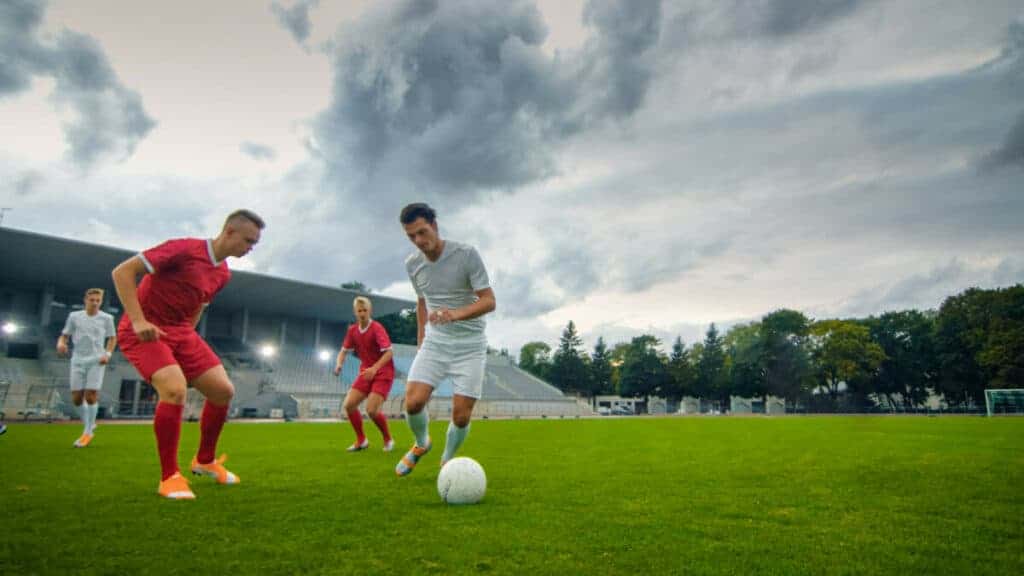Are long runs good for soccer players?
Ever wondered if long runs benefit soccer players? Dive in as we explore the impact of endurance running on a player’s performance on the soccer field!

In order to play well at any sport, you’ve got to do an adequate amount of training, and that includes exercise outside of game practice so that you can better develop your endurance, strength, and skill in specific areas.
It can be assumed that because playing soccer requires the ability to run a lot, going on long runs will help you in actual soccer gameplay, but is this really true? Is it good for soccer players to go on long runs?
Long-distance runs are not the best way for soccer players to train. Soccer requires being able to run fast, in an instant, and at short distances, so training with only long runs will actually weaken the player’s ability to do this. Instead, players should train with short and dynamic sprints.
To learn more about how long-distance runs can be a counterproductive way to train for soccer and what you should do instead, continue reading!
Effects of long-distance running on soccer player performance
Because soccer requires a lot of running during gameplay, it may seem that cross-country running, or any sort of long-distance running will help a soccer player perform better when they play soccer. This is actually not true, as soccer players require a different type of training.
Running in soccer is a different type of running than long-distance running; it requires being able to run in an instant, to be able to change directions and speeds during the run, to run different ways; side to side and backward, and to be able to sprint across a short distance in a very short amount of time while keeping track of the ball and other players.

So, while it is true that soccer requires a good amount of aerobic capacity, just like running does, it requires a different sort of aerobic ability than running in a straight line for a few miles.
The type of running in soccer is more like jogging than cross-country running, so players will perform better if they train with jogging, in addition to other aerobic activities, instead of running or marathon training.
Because cross-country and long-distance runs require a different type of endurance, it can actually weaken your ability to make short-distance and high-intensity sprints.
This is because your body will be conditioned to handle long and steady-paced running and trained to keep a certain heart rate tempo that won’t be enough to keep up with your fellow players in a soccer game.
With more instant sprints, jumping, and muscle endurance required to play soccer effectively, running long distances will actually not improve these skills but rather slow players down.
Long-distance running slows not only your heart tempo, but it develops your slow twitch muscle fibers, making it more difficult to make fast instant runs or change directions while sprinting.
Fitness requirements to effectively play soccer
To play soccer effectively, you need to be able to sprint short and long distances, taking longer strides during the run while changing directions and speeds multiple times during a sprint.
You’ll also need to be able to make long or high jumps and land them, as well as have good maneuvering skills to cut in front of other players and be able to steal and dribble the soccer ball.
Because of this, you’ll need to be able to switch up your movements constantly rather than make one constant movement at the same pace and speed for long-distance runs.
Because you’ll need to be able to endure long distances to play soccer, it should be mentioned that many soccer players actually make great runners in cross country.
This is because they’ve been able to train their muscles to move in all different directions through sprint training and other aerobics.
If someone who plays soccer only trains by running, they won’t develop the additional aerobic skills and abilities that a player needs for a successful game.
Difference between long-distance running and playing soccer

Unlike long-distance running, playing soccer does not involve running non-stop at a slow and constant speed for long distances.
You will, however, be at least jogging for the entire game, whether that be in place to keep your heart rate up as you wait for the ball to be passed to you or while you’re keeping up with your teammates, but you’re also going to be constantly changing speeds as you play, from jogging to fast-paced sprints to high-speed running.
You’ll also have to be able to twist around and move in a completely different direction at any given time during the game, and you’ll be doing this multiple times.
Cross-country and marathons typically require running in a straight line at a steady pace for an extended period of time, with only a few periodic turns throughout the run, but these turns are expected because the route is usually planned ahead of time.
In soccer, you’ll have to be planning moves throughout the game constantly and thus be able to adapt to the changes in the game by changing the direction you are running and switching up your moves several times.
What kind of training should soccer players do instead?
It should be noted that playing cross country or training with running can be a good additional training method to train muscle endurance and breathing exercises for a soccer game, but it shouldn’t be done nearly as often as someone who is training for a marathon, nor should it be a soccer player’s only form of training.
Instead, soccer players should focus on short and dynamic sprinting as conditioning. This way, other muscles and ligaments in the body are being used and exercised that aren’t used in running alone.
Something that soccer players can do to train is make 5-yard shuttle sprints by setting out 5 cones every 5 yards for a total distance of 25 yards.
The player will train by running to each cone and back in one minute, progressing longer distances for each run by running to the next cone and back until they’ve made it to each cone, then resting for the remainder of the minute.
For example, they will set their timer for 5 minutes and at the start, they will run just to the first cone and back, then rest for the remaining seconds on the clock for that minute, then run to the second cone and back, resting for the remaining seconds, then to the third cone and back, resting for the remaining seconds, and so forth until they reach the 5th cone and make it back.
Players can also try a run and jog practice. They will first run a distance of 120 yards, trying to make it in 18 seconds or less, then immediately turn around to jog back to the starting line within the next 30 seconds.
They’ll then rest for 30 seconds while standing. After the 30 seconds are up, they’ll repeat the process until they’ve completed running the 120 yards and jogging back 10 times total. After the 4th and 7th runs, they’ll rest for 45 seconds.
If you complete these training tasks, as well as some other muscle and aerobic training that are described on many soccer coaching websites, you’ll be able to develop the endurance and physicality required to play soccer effectively without needing any long-distance running or cross-country training.
If players want to do cross-country in addition to soccer, they’ll need to complete soccer training exercises more than they train for cross-country to develop better areas of the body that aren’t developed by running.
